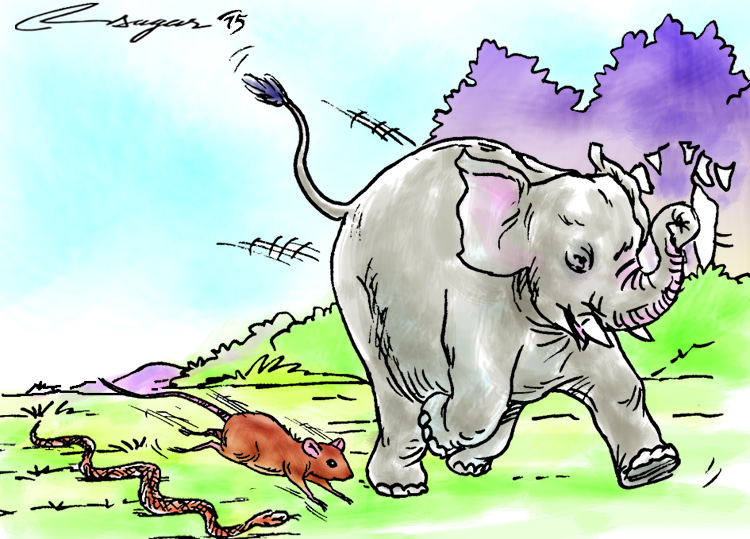Earthquake prediction
Despite some skeptical scientists about animal communication, the discoveries so far made by the experts in Peru, China and in other parts of the world, show what precisely those inventions mean to the conservationists and nature lovers
The most loyal of pets, dogs, rarely howl and bark in an unusual manner. Occasionally, birds chirp strangely and cats purr bizarrely. Their masters usually have no clue as to what they are communicating.
The belief that animals can predict earthquakes has been around for centuries. Historians in 373 BC recorded that animals, including rats, snakes and weasels, deserted the Greek city of Helice just days before a quake devastated the place.
Earthquake prediction perhaps is the greatest failure of modern science as it poses tough challenges to the entire world. Considering prey and predator’s action the conservationists, including herpeto-logists–reptile experts, ornithologists–bird specialist en route to western and central Nepal for their mission on bird conservation have documented some atypical pre-quake behavioral communication by the wildlife and domesticated animals that hopefully could connect with quake predictions.
It was around 11.15am, 25 April, just before an eerie moment of the devastating earthquake, Bishnu Nepal, a local of Basah of Dhading, a neighboring district of Kathmandu, witnessed that two jackals suddenly got out of the jungle and rushed to an open place. Bishnu, at first, was astonished by the jackals’ unexpected appearance, but right after the scary tremor, he realized that the jackals mysteriously knew well in advance that the earthquake was coming.
Manju Silwal, an inhabitant of Nalang-6 Kamdi of Dhading, is now safe. Her dog howled and barked loudly and tried to bite her while she was breastfeeding her baby after weeding her paddy-farm in the morning. Manju yelled at the dog but came out of the house. In a matter of seconds, her home crumbled into rubble. She and her neighbors are now taking special care of the dog.
This can also be correlated with work of Dr Kiyoshi Shimamura of Japan. In October 2003 he hit the headlines with his findings relating to dogs’ erratic behavior and quake prediction. But no follow up researches have been reported thereafter. A cross breed of a Labrador and Domermann dog of Ram Lama, a resident of Sitapaila, howled the day before the quake rattled Kathmandu.
The goat of Manoj Chepang of Chaughara of Korak VDC, Chitwan started bleating in a strange manner, It was around 10 am of 25 April. His father asked him to feed it. Manoj did what his father asked him to do, but the ruminant goat continued whining, instead of eating. They were dazed and alerted immediately after as they experienced a big jolt. Manoj has the conviction that his goat had warned him of the tremor. Like Chepang, Bina Acharya also witnessed a pair of common leopard suddenly rushing to an open space from Bhadrakali forest of Pokhara. Biraj Shrestha, an expert on reptiles in Chitwan, witnessed lots of snakes after the earthquake—amongst many he rescued four of them.
In addition to what a team documented, it has been widely reported that the pet owners claimed to have witnessed that their cats and dogs acted strangely before the tremor—barking or whining or showing signs of nervousness. 77 years old Sabitri Gautam of Dang who firmly believes in birds pre-tremor signals has many anecdotes to tell. Some of birds, she says, never chirp. But when they do it clearly warns of natural calamities. There are other several other stimulating discussions being reported.
A UK based newspaper Daily Mail, for example, reported that for the first time, scientists have filmed the behavior of wild animals in Peru prior to an earthquake, and they believe their study could help improve short-term seismic forecasting. In the research led by Dr Rachel Grant of Anglia Ruskin University, experts used a series of motion-triggered cameras located in the Yanachaga National Park. Although the Seismological Society of America didn’t endorse what the Chinese did in 1975, the researchers there have long studied animals in the hope of discovering what they observe before the earth shakes. The Chinese researches indicate hope that in the days to come they will succeed in doing so. For example in 1975 the Chinese authorities ordered the evacuation of Haicheng, a city with one million people, just days before a 7.3-magnitude quake hit the area. Thus, only a small portion of the population were injured or killed. If the city had not been timely evacuated, it was estimated that the number of fatalities and injuries could have exceeded 150,000. They still continue to look into animal behavioral communication as an aid to earthquake prediction. The American Seismologists are reported to be skeptical about it as few studies were done by the USGS in the 1970s with no concrete results.
Despite some skeptical scientists about animal communication, the discoveries so far made by the experts in Peru, China and in other parts of the world, show what precisely those inventions mean to the conservationists and nature lovers. It is very loud and clear. Hence, it is expected that the scientists, including conservationists,, herpetologists, ornithologists, geologists, seismologists will continue to study the behavior of animals for clues to early earthquake warning system.
Gurung is former Spokesperson for the Office of the UN High Commissioner for Human Rights in Nepal, and Acharya is a graduate from the University of Wales, (UK) and a bird conservationist






